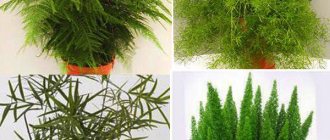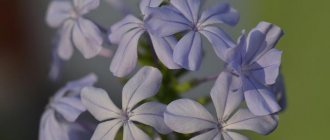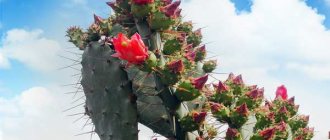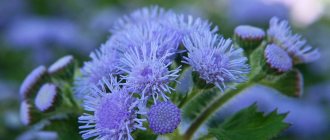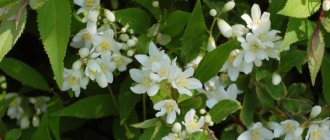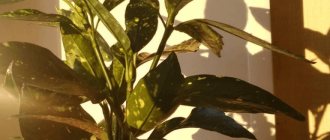Nowadays, plants of unusual colors, especially red, are gaining popularity, and we are not talking about the color of the flowers themselves. Plants with red leaves look fresh, bright, beautiful, interesting, they can charm at first sight and decorate any room. By the way, the red color appears due to anthocyanin pigments. There are a lot of ideas on how to decorate your home or work space with such plants! You can make a green corner by immediately combining different crops with green and red foliage, or create a simpler composition, or you can simply put one bright specimen in a prominent place.
Poinsettia
The beautiful poinsettia is also called Euphorbia most beautiful, Christmas star. A bright representative of the Euphorbiaceae. The most beautiful euphorbia is loved for its unpretentiousness and longevity - it is literally capable of delighting with its beauty for many years, requiring in return minimal but regular care.
Conditions for growing beautiful milkweed:
- Temperature: in summer about +20-25°C, in winter - about +16.
- Lighting: full, a south or south-east window is suitable.
- Watering: moderate, about 2 times in 7 days, in cold weather - 1 time in 3-4 weeks.
- Air humidity: normal, spraying with water is welcome, poinsettia can withstand dry air, but it has a bad effect on decorativeness.
- Pests: scale insects, spider mites, thrips.
- Reproduction: by apical stem cuttings.
Caladium
Thanks to its leaves, caladium looks more like some kind of extraterrestrial plant. It is distinguished by a combination of interesting colors and colorful veins.
Conditions for keeping and caring for caladium:
- Temperature: in summer - 20-25, in winter - 15-19.
- Lighting: grown in bright places that are protected from direct sunlight, comfortable on an east or north-west window.
- Watering: moderate, when adding moisture, do not allow water to get on the leaves, stops in winter.
- Humidity: high, regular spraying of the soil surface is recommended.
- Reproduction: daughter tubers.
- Pests: aphids, mealybugs.
- Feature of the culture: in the fall the leaves begin to die and in the winter the caladium is dormant.
Main types of Fittonia and photographs of these species
To date, flower growers have been able to develop several types of phytonia that can be grown in an apartment. The Fittonia genus consists of four species of perennial herbaceous plants with beautiful leaves in a variety of green, pink, white, and purple shades. Red Fittonia looks especially unusual and exotic, the veins on its leaves form an intense, beautiful pattern.
Fittonia Verschaffelta
This type of plant is characterized by the presence of beautiful large dark green leaves with a pattern of white, red and pink veins. The stems of Fittonia Verschaffelta are highly branched, with creeping shoots.
A low-growing plant no more than 25 cm high, it loves high humidity and a warm growing environment. Great for creating flower arrangements.
Fittonia Skeleton
This species got its name because of its color and leaf structure.
This type of indoor plant is very beautiful and elegant, with creeping shoots. The small, velvety, matte leaves of Fittonia skeleton are decorated with a dense network of red veins. The leaves are a rich olive color, their coloring is so intense that it creates a luminous effect.
Fittonia Mix
A low perennial plant whose main decoration is its leaves. This species contains several varieties of plants that are planted together.
The color of Fittonia mix leaves varies from light to dark green shades, with multi-colored bright veins. This plant looks great on a windowsill due to its variety of colors.
Aglaonema
The evergreen exotic is a member of the Araceae or Aronicaceae family. Grows well in regular substrate and hydroponics.
Conditions for aglaonema:
- Temperature: in the warm period - 20-25 degrees, in the cold - 16-18, but not lower.
- Lighting: full, but diffuse, south-west or south-east windows are suitable.
- Watering: plentiful in the summer, reduced later, but you need to make sure that the soil in the pot never completely dries out.
- Humidity: high, requires spraying with warm water.
- Reproduction: seeds, apical cuttings, suckers, dividing the bush.
- Pests: spider mites, mealybugs.
Pests and diseases
The most dangerous pests for the flower are aphids, thrips, as well as scale insects and mealybugs. But you can deal with them if you detect them right away and act quickly.
- They appear as yellow spots on the leaves. Suck out the juice of the plant.
- They look like small-diameter brown plaques on the surface of the plant. As a result of the appearance of such a “neighborhood”, the leaves turn pale and dry out, as the parasite feeds on the juice of the Fittonia.
- Barely noticeable whitish spots on the leaves and the finest cobwebs under them are signs of a mite. If you don't fight it, it will entwine the entire flower.
- Aphid parasites settle on the tips of the leaves of the plant and feed on its sap. If detected early, it can be quickly eliminated.
- If the plant seems to have been sprinkled with flour on top, it is a scale insect. Moreover, they can be very prolific. And then the larvae will literally stick to the entire underside of the leaves. You need to act quickly, otherwise the plant will die.
How to act and what needs to be done? Everything is not complicated enough. Immediately isolate the “sick” from other plants. In the bathroom from the shower, rinse off all the parasites and then spray with any available insecticide. In fact, that's all. But it is important to remember that any parasite multiplies very quickly, the disease occurs rapidly. Therefore, it is very important not only to treat plants in a timely manner, but also to organize prevention. It's also not complicated:
- Inspect the leaves and the condition underneath them regularly. Inspect the stems and the condition of the soil around the flower.
- Keep pest control preparations in your herbal medicine cabinet. Insecticides can be anything from specialized to universal. In principle, they all work quite well.
- As soon as you notice something is wrong, immediately treat the plant. And during his recovery, take him to a place where there are no flowers at all. To see how everything goes. And if everything is fine and the pet is healthy, it can be returned to its place.
Cordilina
Cordyline leaves are highly decorative. Representative of the Sparzhevs. The crop can be grown in soil or hydroponically.
Features of growing Cordyline:
- Temperature: in summer - 20-25 degrees, in cold weather - not lower than 18, should be protected from drafts.
- Lighting: A bright place is suitable for variegated cordylines, but direct sunlight should be completely excluded.
- Watering: in summer, moisture should be added abundantly, avoiding drying out or waterlogging of the earthen clod; later they are reduced, but you should also not allow the soil to dry out.
- Air humidity: high, regular spraying is recommended.
- Reproduction: through seeds, division of rhizomes, cuttings.
- Pests: aphids, thrips, scale insects.
Characteristics of Fittonia
In nature, Fittonia is found in the vast expanses of South America, where, in numerous forests, Fittonia occupies huge layers of land.
The name comes from the names of the learned ladies who created the world's first textbook on botany.
Fittonia is very popular all over the world; many people grow it for sale.
Of the whole dozen species, only a couple of varieties are truly indoor Fittonia, these are silver-veined Fittonia and Verschaffelt Fittonia.
Both of these species are small-leaved, which adds miniature and neatness to the flower. The houseplant does not reach a significant size; a very small flowerpot is suitable for growing a flower, which can be placed in any convenient place, the main thing is that it is well lit.
But we will devote the next section to caring for Fittonia.
Coleus
Coleus has two strong advantages: firstly, it is unpretentious, and secondly, it is very colorful and beautiful. Many of them have interesting colors - green borders around the edges and a mottled middle. Representative of the Lamiaceae (or Lamiaceae).
In order for Coleus to please its beauty, it is necessary to satisfy its requirements:
- Temperature: in summer +18-20°C, in winter +12-14, not lower.
- Lighting: for maximum decorativeness, the crop requires full lighting, but direct exposure to rays should not be allowed, the light must be diffused.
- Watering: in spring and summer, abundantly when the top layer of soil in the pot dries, in the cold period it is reduced, but the soil should not be allowed to dry out.
- Air humidity: high, spraying will be beneficial.
- Pests: whitefly, spider mites, aphids.
- Reproduction: cuttings, less often seeds.
Oxalis (Oxalis)
Oxalis, oxalis, lucky clover, sour clover, hare cabbage - these are different names for the same plant. By the way, such names were chosen for a reason; the leaves of the representative of the Kislichny family are really sour. Flower growers are very fond of this crop for its colorful and delicate leaves that resemble butterflies. Oxalis is exactly the case when not only the color, but also the shape of the leaves causes admiration.
Some nuances that are important to know for successfully growing sorrel at home:
- Temperature: in summer 20-25, in winter - 16-18.
- Lighting: bright, but always diffused; direct rays can cause burns.
- Watering: plentiful, but the drainage system must be of very high quality, excess moisture is critical for it, during cold periods the amount of water decreases, you just need to maintain light moisture in the substrate.
- Humidity: moderate to slightly higher than normal room humidity.
- Pests: scale insects, aphids.
- Reproduction: by nodules or daughter bulbs.
Nidularium
Attractive because of its glossy, shiny, dense leaves. The highlight of nidularium is given by the bracts, colored red. Refers to Bromeliads.
The following conditions are suitable for decorative deciduous plants:
- Temperature: in warm weather +20-24°C, in cold weather +18-20.
- Lighting: partial shade, strong shadow and direct sunlight are not allowed.
- Watering: moderate, waterlogging should not be allowed; moisture should be added when the soil dries out. In spring and summer, it is recommended to add moisture through the leaf funnel, and in the cold period - in the standard way.
- Humidity: normal room humidity, in dry air you need to spray the leaves.
- Pests: scale insects, mealybugs.
- Reproduction: daughter rosettes.
Croton (Codiaeum)
Croton has attractive leaves. The codiaum flower is not particularly decorative; it is often simply torn off so that it does not take away excess energy. A representative of the Euphorbiaceae family has a truly fantastic color, combining several colors at once: red, yellow, green, pink, orange. This amazing combination will appeal to lovers of picturesque and rich colors. Codiaum also has an interesting feature - milky sap in the stems and leaves.
However, croton is demanding in care; it cannot be called unpretentious and unpretentious:
- Temperature: in summer +20-23, in winter +17-18, t should not fall below 17 degrees. It is also important to avoid any drafts.
- Watering: abundant in spring and summer, perform the procedure when the top layer of soil dries 1 centimeter. In winter, the introduction of moisture is reduced.
- Air humidity: high, it is necessary to regularly spray the leaves and clean them of dust.
- Lighting: should be full, but should be protected from direct rays. Therefore, it is better to place the pot on the east or west side.
- Pests: rarely affect due to the poisonous sap, but under unfavorable conditions (dry air) scale insects are possible.
- Reproduction: apical cuttings, air layering.
Useful properties of fittonia
It’s probably no secret to many that Fittonia is popularly considered an excellent natural air purifier. And indeed it is. The plant can make indoor air fresher and cleaner. In addition, the flower also helps to normalize sleep - which is why the plant is often recommended to be placed in children's bedrooms.
Among other things, the big advantage of fittonia is that it is not poisonous. Therefore, you can safely grow plants at home without fear that animals or small children may be poisoned.
Irezine
The compact bush amazes with its lush and colorful beauty. The variegated leaves are painted in an attractive beet red color.
Features of growing irezine at home:
- Temperature: in the warm period - 19-25 degrees, in the cold - 15-18.
- Lighting: the light-loving crop prefers full lighting; on a south window it is recommended to make it diffused.
- Watering: abundant (when the top layer of the substrate dries out), reduced in winter, but do not allow the soil to dry out.
- Humidity: normal, periodic spraying will be beneficial.
- Pests: aphids, whiteflies.
- Reproduction: stem cuttings.
- Feature of caring for irezine: you should periodically pinch the tops of the shoots to form a beautiful bush.
Reproduction procedure
Cuttings
The most popular propagation of Fittonia in home floriculture is by cuttings. Planting material is obtained by pruning the plant. The tops of shoots 5–8 cm long are rooted in water or wet sand. Each should have at least 3-5 leaves.
Rooted cuttings are the fastest and most effective way to get a new fittonia
- The cutting is lowered into a container, at the bottom of which a thin layer (no more than 1 cm) of water is poured, or it is stuck vertically into the sand and covered with a glass jar of suitable volume. To create a greenhouse effect, it is recommended to place a container of water in a large plastic bag and tie it.
- The optimal temperature for rooting Fittonia cuttings is +23…+27 ºС. Once every 4–5 days, the “greenhouse” is removed and the leaves are sprayed. In such conditions, roots will appear in 5–6 weeks. But 2.5–3 months is a very likely period. So please be patient.
Some experienced gardeners recommend the following method, which is gentler on the plant:
- The chosen section of the trunk is pinned to the ground with a pin or a piece of wire, 2-3 pairs of leaves are torn off on both sides of this place and lightly sprinkled with soil.
- When the roots appear, the new plant is carefully separated from the “parent” and transplanted into an individual pot with soil suitable for adult fittonias.
Rooted Fittonia cuttings take root well
Rooting cuttings of indoor plants in water - video
Dividing the bush
The procedure is carried out simultaneously with the transplant. Often they do not resort to it, because the fragile roots of Fittonia are very easy to damage.
To minimize the risk of plant death, the roots are washed under running water, then placed in a pale pink solution of potassium permanganate for 10–15 minutes. The separation operation is carried out with a sharpened sterile knife or scissors.
The plant must be cut so that each part has several healthy shoots. The root system is divided approximately equally between them.
Dividing Fittonia is associated with great risk - you can lose both plants
New fittonias are kept under a glass jar for 10–12 days. After this time, it is removed daily, gradually increasing the period of time the flower remains under normal conditions. After a month, move the pots to a suitable place and care for the Fittonias as usual.
Video: transplanting Fittonia by dividing the bush
Neoregelia
It is similar to Nidularium, but this is not surprising, because they belong to the Bromeliads. Neoregelia is attractive because of its beautiful glossy leaves and variegated bracts.
The conditions acceptable for neoregelia are simple:
- Temperature range: in summer +21-25°C, in winter - +16-18. It is very important that there is good ventilation and neoregelia has access to fresh air, but it should be protected from drafts.
- Lighting: bright diffused light without direct light.
- Watering: you need to pour water into the rosette of leaves, in winter - under the root.
- Humidity: high, it is recommended to use a humidifier or spray frequently. It is also important to remove dust from the surface of the leaves.
- Pests: aphids, mealybugs, bromeliad scale insects.
- Reproduction: daughter rosettes.
Cryptanthus
Cryptanthus is another striking representative of the Bromeliad family. The color of the leaves will appeal to lovers of unusual color combinations. The pattern also looks interesting.
The nuances of growing cryptanthus:
- Temperature: in summer 21-24 degrees, in winter 18-20, without drafts.
- Lighting: loves sunny, bright areas in the house, but without direct sunlight, very light partial shade is allowed.
- Watering: in spring and summer it is necessary to constantly maintain moderate soil moisture. It is important to avoid excess and lack of moisture. The main thing is stability, without sudden changes. In cold weather, the procedure is performed much less frequently; after the top layer of soil has dried, moisture should be added the next day. Water at the root, do not bring water into the outlet.
- Humidity: Cryptanthus needs high air humidity, which must be maintained constantly. An air humidifier or spraying several times every day will help.
- Pests: spider mites, thrips.
- Reproduction: by lateral shoots.
Caring for Fittonia at home
The rules for caring for this rather capricious tropical guest are generally not complicated. We draw your attention to the fact that the larger Fittonia looks, the more care it requires. If you do not have a paludarium or display case in your house suitable for growing it, then it is better to purchase a small compact specimen. You can read about the types and varieties of Fittonia in the corresponding article, and here we will introduce you to the basic rules for growing a flower.
Lighting and flower locations
Sufficient lighting is necessary for Fittonia to maintain the bright color of its leaves and the healthy decorative appearance of the flower all year round. The plant does not like extremes. It is not the most shade-loving plant, but it is certainly the most sun-fearing. She loves natural diffused light in summer, but not the sunny windowsills of south-facing windows. Fittonia leaves lose their amazing color from both excess lighting and lack of it. Place the pot with the plant next to a window facing west or east on a shelf or coffee table, in partial shade. In the wild, the flower does not receive direct sunlight at all. It is not surprising that at home, direct sun, even in the morning and evening hours, can destroy it. The flower also cannot withstand drafts and sudden changes in temperature, so it is better not to place it on unprotected balconies and verandas for the summer - it is better to remain in its familiar indoor environment.
In winter, the southern direction of the window sill is preferable to others, but place the pot with the plant away from heating appliances so as not to provoke the flower to shed its leaves. In the winter months, Fittonia feels good under a fluorescent lamp or phytolamp.
Florarium and paludarium
Some gardeners grow Fittonia in transparent containers made of plastic or glass, even in ordinary glass jars. Select a container with a tight-fitting glass lid. A little soil suitable for growing Fittonia is poured onto the bottom and moistened. Carefully plant the plant and close the jar. When condensation forms in the jar, remove the lid, ventilate the container for two hours and close it again. This procedure will have to be carried out for some time, but after 10 days the release of condensation should stop - the microclimate necessary for the plant will be established in the jar. To decorate the composition, beautiful pebbles, marble chips, decorative clay figurines and other lovers of the tropical environment are placed in a jar with a flower - moss, miniature ferns, some types of orchids. It turns out to be a very unusual, but effective decoration for the interior of the room.
But this method of growing a flower has its weaknesses. In greenhouse conditions, Fittonia will grow very quickly, and pinching and pruning the plant, and even more so replanting it, through the narrow neck of the jar is quite problematic.
Then lovers of this tropical sissy purchase an aquarium for growing Fittonia, a special semi-closed transparent one, made of glass or plastic, reminiscent of an aquarium for breeding fish - a florarium.
Florarium
There are many advantages to growing this way:
- Fittonia will be protected from drafts, temperature changes, and drying out of the soil. The flower should be watered no more than once or twice a month.
- Most often, these florariums have a wide neck and a rounded shape, which allows manipulation by pinching and trimming excess shoots. Fittonia in aquariums should not be allowed to grow too much; as the bush grows, it needs to be thinned out.
- There is no need to constantly monitor air humidity, since all the evaporated moisture is retained inside the closed aquarium. Just try to provide the plant with good lighting so that the flower does not stop growing.
- Florariums look good and fit into the interior of the apartment.
But growing Fittonia in it can also end disastrously if you have little experience in keeping flowers this way - you can damage it when replanting or cleaning the aquarium, or overfeed it with fertilizers, overwater when watering and cause rotting of the roots.
Paludarium
Finally, Fittonia can be grown in paludariums. This is an interesting, but the most expensive and time-consuming way to grow tropical sissy at home. The purchase of a spacious transparent planting container and special equipment to maintain optimal levels of illumination and humidity in it require large expenses. In good light, Fittonia will not suffer if its roots are completely submerged in water. However, it is better to place a plant with a well-developed root system in a paludarium. When cleaning the aquarium, try to disturb its resident as little as possible - from any mechanical damage to the roots it can rot and die. Paludarium has significant advantages in terms of crop production compared to other methods of growing it. Fittonia grows well in it in a terrestrial, semi-submerged and even underwater version. The lighting and humidity it needs are maintained by technical means. All kinds of streams and fountains create ideal conditions for the existence in paludariums of all types of Fittonia, without exception.
This may be interesting: Nerthera (Coral berry) - home care
Temperature
The plant does not like too cold or too hot ambient air. Does not tolerate drafts and sudden temperature changes. The optimal temperature for its year-round maintenance is 21 °C, but an acceptable temperature should be in the range of 20 - 25 °C. Temperature below 16 – 18 °C. Fittonia may not survive at high air and soil humidity.
Ambient humidity and spraying
High humidity is the most important factor in the well-being of Fittonia. Humidity less than 65% is considered critical. Optimal air humidity tends to 85%. To do this, you need to regularly, in the morning and evening, spray the leaves of the plant and the surrounding area from a fine spray bottle with lukewarm, settled water. Moreover, this must be done even in the winter months, when the indoor air becomes especially dry due to the operation of heating devices. It would be nice to have a humidifier in the room. Pallets with wet expanded clay or moss, in which you can place pots with Fittonia, will increase the humidity.
Watering
The root system of the plant reacts negatively to both dry soil and generous waterlogging - the leaves immediately begin to wither. Fittonia should be watered regularly and abundantly in summer, 2-3 times a week, and in winter once a week is enough. You need to pour water into the pot until air bubbles stop appearing on the surface of the soil and excess water appears in the pan. After 30 minutes, drain it. Now you will be sure that the entire earthen ball is completely saturated. Constantly check the moisture content of the substrate, and when the top layer of soil in the pot dries out a little, then you can and should water it again. Water for watering Fittonia should be warm and allowed to stand for 24 hours. Ideally, melt water, rain water or distilled water is suitable. Often, you have to water with ordinary tap water, which contains chlorine, fluorine and calcium compounds. We recommend adding a couple of drops of lemon juice or 2-3 crystals of citric acid to such water before watering, letting it sit for a day so that all the impurities precipitate and only then use it for watering Fittonia.
Remember that the flower will still withstand temporary dryness of the soil; after watering, the turgor will be restored, although it will lose some of the leaves. But from excessive watering and stagnation of water in the pan, the roots of the plant can rot, and it will die - it is almost impossible to stop the rotting of the root system.
Bottom watering is absolutely not suitable for Fittonia!
Top dressing
From spring to autumn, Fittonia can be fed twice a month; in winter, it is enough to feed it once a month. To do this, use liquid mineral fertilizers for decorative deciduous plants, only in doses reduced by 2 times than indicated on the packages. You can sometimes combine feeding the plant with spraying it, i.e. add liquid fertilizer to the water to spray the flower.
We do not recommend using wax-based leaf products that are now fashionable, as they create an airtight layer on the leaf surface that interferes with normal leaf photosynthesis.
Soil and pot
For Fittonia, purchased soil for Azaleas, Violets or Geraniums is suitable. If you prefer to prepare the substrate yourself, make sure that it is loose, moisture-permeable and breathable, and capable of retaining moisture well. Mix two parts each of turf and pine soil and one part each of dry peat and river sand.
Choose a pot for Fittonia that is not deep, but wide. The entire root system of the plant is located within ten cm below the soil surface and grows in breadth. Let the pot be ceramic in the form of a bowl, with a mandatory drainage hole in the bottom. If the diameter of your pot is smaller than the height, then at least a quarter of the pot should be occupied by drainage - expanded clay or pebbles, otherwise moisture will stagnate in it, and the flower will suffer from dampness and excessive soil moisture.
Transplanting a plant
Young Fittonia bushes should be replanted every spring into new pots, slightly larger in size than the old ones. An adult plant can be replanted less often, once every two to three years. To transplant a fragile plant, they use the method of transferring the flower together with a lump of earth into a new planting container. We recommend immediately replanting Fittonia purchased in a store into a suitable substrate, since store-bought soil usually does not meet the requirements of a tropical beauty. Let us repeat, replant carefully, trying not to damage the fragile roots of the plant, along with the lump of earth. Trim shoots that are too elongated. Water it. If the soil settles too much, add it so that there are no voids in the pot and the roots do not look out. If the planting container is wide enough, you can place several Fittonias of different types into it at once - the composition turns out to be very impressive. After transplantation, the plant is kept in a shaded place until its growth resumes.
This may be interesting: Caring for arrowroot at home
Trimming
In order for Fittonia to bush, as well as to stimulate it to branch more intensively, the shoots are regularly pinched or cut to a quarter of their length. This maintains the decorative appearance of the plant. In addition, over time, after two or three years, the stem will become bare from below. Trimming the stem and pinching the shoots will also help - a rejuvenating effect will occur, and the lost decorative effect will return to the flower. Just don’t cut off all the shoots at once - there should be leaves left on the Fittonia. Cut out the old shoots onto the stump one by one, wait until young shoots appear on the previously cut stem. Sometimes such pruning lasts for a year or two, but do not cut off all the shoots completely - you can destroy your beauty.
By the way, cut parts of the plant can be used for rooting and flower propagation.
Lifespan
According to statistics, for a novice amateur gardener, Fittonia lives in beautiful decorative form for no more than six months, then problems begin. The plant loses its decorative effect and often dies. Experienced flower growers who have managed to create ideal growing conditions for the tropical sissy will be able to admire the wonderful leaves of their beauty, Fittonia, for several years. After these years, the old plant is replaced by its younger generation, using one of the propagation methods described below.
Maranta
An attractive feature of arrowroot is its bright red veins. The combination of scarlet, dark green and light green shades makes this decorative foliage plant stand out. Belongs to the Marantaceae family.
Conditions for growing tropical exotics:
- Temperature: in spring and summer +22-24, in winter and autumn +18-20. Protection from any drafts is important.
- Lighting: bright, but diffused light, but can withstand slight shading.
- Watering: during the warm period, plentiful, it is necessary to maintain moderate soil moisture, and the soil surface should not be allowed to dry out. In winter, the procedure should be performed less frequently; the surface of the top layer of soil should dry out.
- Humidity: high, it is necessary to regularly spray the arrowroot, and it is also useful to periodically clean it in the shower.
- Pests: spider mites.
- Reproduction: by dividing the bush, apical cuttings.
Description
The description of the flower differs from species to species, but they have similar general features. The flower bushes are low with slight pubescence. The leaves are spicate. Growing alone, they are yellow in color. United flowers tend to be reddish in color.
The stems have a distinctive green color, with barely noticeable purple tints in the veins. The plant takes root easily, the rules of care and cultivation are traditional. At normal temperatures and sufficient light, the flower will sprout within a month.
Begonia royal
The plant is also called Begonia Rex. It blooms rather inconspicuously, so flowering cannot be called the main trump card of a representative of the Begoniev family. The main beauty of the royal begonia is its variegated and luxurious leaves.
- Temperature: about 19-22 degrees, in winter - about 16.
- Lighting: bright, but the sunlight must be diffused; direct rays can cause burns to the foliage.
- Watering: abundant, you need to add moisture immediately when the top layer dries.
- Air humidity: normal or very slightly increased.
- Pests: thrips.
- Reproduction: through seeds, cuttings, division of the root system.
Where and how does it grow
The very attractive Fittonia flower is a perennial plant and consists of branched stems that spread along the ground. This plant has a height of up to 10 cm, a superficial fibrous root system. Upon contact with the ground, the fuzzy stems take root. The oval-shaped petiolate leaves are located close to each other, smooth, with blunt edges. The leaves are fleecy on the reverse side, their length is 6-10 cm. The olive-green leaves along the veins have thin shiny stripes. On young leaves these stripes are silvery, yellow or pink, and as they reach adulthood they become greenish.
In spring or summer, a long peduncle grows from the leaves of the plant, which produces small buds resembling a spikelet; the flowers themselves bloom alternately from bottom to top. In terms of aesthetics, they do not have much value. Their diameter is up to 1 cm.
The plant is low-growing, so it can easily be grown indoors. But there are exceptions: fittonia can be creeping or reach gigantic sizes. Canopy and ground cover cultivation of this crop is popular.
Hypoestes
Hypoestes belongs to the Acanthus family, it will decorate and enliven the decor of any room. Variegated leaves will appeal to lovers of variegated and unusual colors and patterns.
Features of hypoestes:
- Temperature: in spring and summer +22-25°C, in winter +17-18.
- Lighting: bright diffused.
- Watering: in warm weather, abundant when the top layer of soil dries. In winter, add moisture 1-2 times after the top layer of soil dries.
- Air humidity: high, spraying recommended.
- Pests: not susceptible.
- Reproduction: cuttings, through seeds.
As you know, red is the color of wealth and prosperity; it is believed that its presence in the house can attract success. It is possible that such thoughts have no basis in reality, but it is a reality, not a fiction, that color therapy works and with regular visual contact a person’s mood improves. Looking at a variegated houseplant with a red tint, you can lift your spirits, and a good mood - the key to good health.
Planting and transplanting procedure
Fittonia needs to be replanted every 2–3 years, since with age the plants noticeably lose their decorative properties. The lower leaves gradually fall off, exposing the trunk. The best time for the procedure is early spring.
A new voluminous and deep pot of Fittonia is not needed. The entire root system of the flower is located approximately 6–8 cm below the soil surface. Choose a ceramic bowl that looks like a soup bowl. An additional plus is the presence of a large drainage hole. But still, about a quarter of the pot’s volume will be taken up by drainage. This could be expanded clay, small ceramic shards, pebbles, or brick fragments.
The Fittonia pot needs to be wide, but not too deep
Specialized stores sell a special substrate for azaleas, violets or geraniums, which is quite suitable for fittonias, but experienced flower growers prefer to prepare the soil themselves. The main requirements for it are lightness, breathability and the ability to retain moisture.
Fertile turf soil from the garden, coniferous soil, dry peat, coarse river sand are mixed in a ratio of 2:2:1:1. Coniferous soil can be replaced with a substrate in which heather grew.
It is better to replant Fittonia purchased in a store immediately, without waiting for the right time. The universal soil used by indoor plant growers does not meet the requirements of a rather capricious flower.
The transplant procedure does not have any special features. The only requirement is to be careful with the thin and fragile roots of Fittonia. They are very easy to damage. Therefore, if possible, the plant is transferred from the old pot to the new one with all the earthen lump. You can place several types at once in one container.
Compositions of several fittonias look very impressive

